Content provided in partnership with Seesaw Magazine.
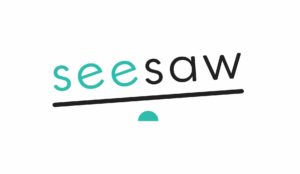
Fremantle Arts Centre’s annual “Revealed” exhibition of works by new and emerging WA Aboriginal artists is an exciting and engaging collection, writes Belinda Hermawan.
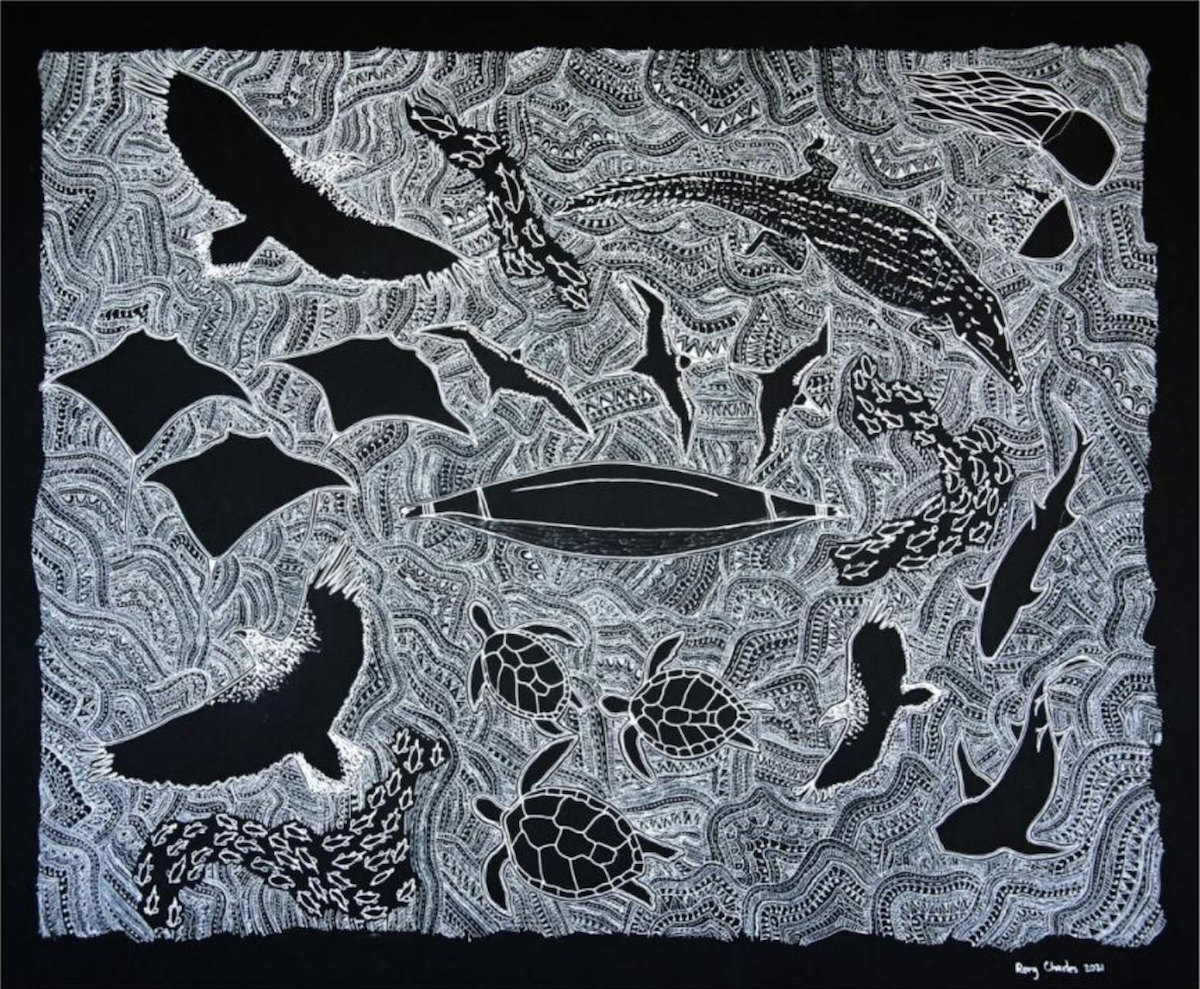 Rory Charles, ‘Saltwater Country Kalumburu’, 2021, paint pen on black paper, 61 x 81cm. Image courtesy of the artist.
Rory Charles, ‘Saltwater Country Kalumburu’, 2021, paint pen on black paper, 61 x 81cm. Image courtesy of the artist.
“Revealed Exhibition 2021: New and emerging WA Aboriginal Artists”, selected by Glenn Iseger-Pilkington and artist Esther McDowell/Yabini Kickett and curated and installed with assistance from the 2021 Revealed Aboriginal Artsworkers* · Fremantle Arts Centre ·
Showcasing contemporary artworks from over 100 new and emerging First Nations artists from remote, regional and metropolitan Western Australia, this year’s “Revealed” exhibition at Fremantle Arts Centre is a triumph of scope. With artists selected by curator Glenn Iseger-Pilkington and artist Esther McDowell/Yabini Kickett, the exhibition includes a multitude of exciting and engaging themes and art-forms.
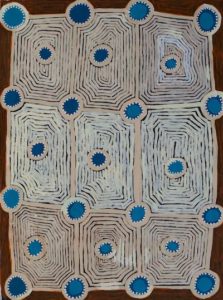 Pauline Williams, ‘Kunawarritji Rockholes’, 2020, acrylic on canvas, 122 x 91cm. Image courtesy of Martumili Artists.
Pauline Williams, ‘Kunawarritji Rockholes’, 2020, acrylic on canvas, 122 x 91cm. Image courtesy of Martumili Artists.
A striking feature of the 2021’s “Revealed” is the variety of colour palettes. Particularly notable is the use of vivid purples, pinks and blues, which evoke a sense of boldness, celebration and movement. The marine blues in Kurnawarritji Rockholes (2020), by Pauline Williams, a Perth-based Martu artist, and in Celebration on Grandfathers Country (2019), by Ngaanyatjarra artist Thomas Reid, give life to the artists’ respective family histories.
In contrast, the precise geometric linework in Kalka artist Phyllis Donegan’s Tali Tjuta (2020-2021) paintings is mesmerising in orange.
Insight into the experiences of First Nations people is showcased in the photography selection. In Untitled #1 (2020) and Untitled #2 (2020), young Wongatha photographer Chenise Cameron captures the vastness and incredible beauty of the rural landscape; our smallness compared to the universe. The perspective of the person – one subject looking at the camera, one facing away – is also interesting.
What we choose to see and how we approach it is often indicative of one’s mindset: in Mud doesn’t bother me (2020) by Karajarri/Kurama/Ngarluma photographer Sharlene Phillips, the subject is undeterred, while car wreckage has been transformed into art in Martu artist Ignatius Taylor’s Jilla Car (2020).
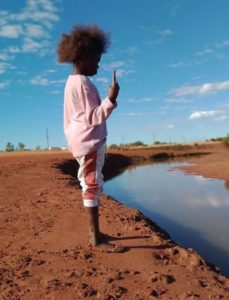 Sharlene Phillips, ‘Mud Doesn’t Bother Me’, 2020, photographic print, 30 x 23cm. Image courtesy of Spinifex Hill Studio.
Sharlene Phillips, ‘Mud Doesn’t Bother Me’, 2020, photographic print, 30 x 23cm. Image courtesy of Spinifex Hill Studio.
Aboriginal art is an enduring method of storytelling, and in this exhibition the various portrayals of family, living off the land and passing on traditions, make for an immersive experience. One example is triptych Woman, Dish, Digging Stick (2021), by Yindjibarndi-Martu woman Leanne Peck, representing the artist’s “old nana” hunting and gathering using traditional tools, walking for miles before then making a fire and eating together with her. The lino print is first printed in black only, then in red and black, and lastly in blue, white and red. The set speaks to a layering of experience and growing meaning as time goes on; the core elements are the same, and each new generation can partake in their culture.
“Revealed” also provides a platform for artists producing textiles, sculpture, jewellery and installations. A new experience for me was the wildlife sculptures woven from wild grass and other materials. For each of her Tjanpi Desert Weavers (2020), Chriselda Alkuwari Farmer, a Ngaanyatjarra artist, has adopted the design of Ngaanyatjarra weavers and put her own spin on it by using brightly coloured raffia and wool to give her flock of birds character. Fellow Ngaanyatjarra artist Erica Ikunga Shorty’s Tjulpu (2020) birds have even more personality in their designs – it’s impossible not to smile at their playfulness and individual eccentricities.
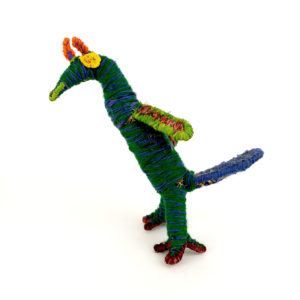 Erica Shorty Ikunga, ‘Tjulpu’, 2020, tjanpi, raffia, wool, 18 x 13 x 22cm. Image courtesy of Tjanpi Desert Weavers.
Erica Shorty Ikunga, ‘Tjulpu’, 2020, tjanpi, raffia, wool, 18 x 13 x 22cm. Image courtesy of Tjanpi Desert Weavers.
For all my enjoyment of colour, the most successful wildlife piece for me was Wiradjuri artist Rebecca Reid’s acrylic painting of a black cockatoo. The native bird in Malangun (2020) has incredible dimension, a sparing use of blue and orange creating depth and fine highlights of gold adding a celestial sparkle.
Moreover, Rory Charles’ intricate linework firmly establishes him in my mind as a young artist to watch.The Wunambal Gaambera, Nyikina, Balanggara and Gooniyandi artist’s intricate white linework on a black background in Saltwater Country Kalumburu (2021) depicts in magnificent detail the harmony and richness of the Kimberley ecosystem and the movement of its air and aquatic wildlife (pictured top). The artwork is full, bursting with life.
Conversely, in WW2 Bombing of Drysdale River Mission, Kalumburu (2021), Charles utilises negative space to portray a story from his great, great grandmother, imposing a sense of scale and doom by allowing the black sky and the size of the bomber planes to overwhelm the town beneath. It’s breathtaking work from a Year 12 student.
The healthy attendance at FAC on a rainy Sunday morning proves audiences are eager to see work from WA’s Aboriginal Art Centres and independent artists. With this much talent in one exhibition, it’s worth the visit!
“Revealed” is exhibiting at the Fremantle Arts Centre until Sunday 23 May.
- The 2021 Revealed Aboriginal Artsworkers are Leonie Bennett and Dianne Wamantjangu (Tjarlili Arts); Kimberley McKie (Spinifex Hill Studios); Savannah Travia-Dann (Perth) and Amanda Bell (Busselton).
Pictured top: Chenise Cameron, Untitled #2, 2020, photographic print, ed. 1 of 3, 61 x 60cm
See more Art Exhibitions in Perth
[widget-v2-html]data-prop-widget-view=grid data-prop-region=perth-and-surrounds data-prop-type=events data-prop-features=10374 [/widget-v2-html]